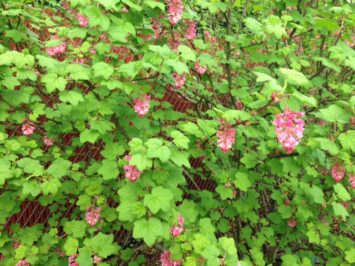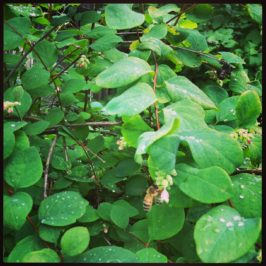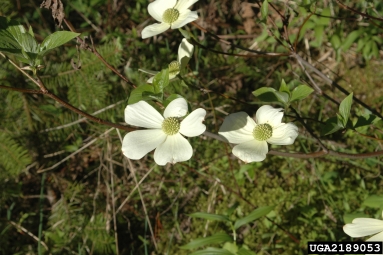There are plenty of stories in the news to worry about – especially for those of us concerned about climate change and the environment.
In the urban environment, wildlife habitat is shrinking, and bee and pollinator populations are also on the decline.
Planting native plants and trees to help human-managed landscapes adapt to climate change is one simple, but important, thing we can do. And, native plants in the yard and garden boost the ecosystem services of the entire neighborhood.
With spring just around the corner, what better time to take a proactive stance by mindfully strategizing on some great plant choices for yard and garden?
Busy urbanites will appreciate that many of these plants are not only helpful to the environment but are low-maintenance, as well.
Here are a few ideas to get you started.
Red-flowering currant (Ribes sanguineum)

Red-flowering currant makes a great landscape addition
This large deciduous shrub is easy to grow and bears lovely eye-catching pink or magenta flower clusters in early spring. A magnet for hummingbirds, these plants prefer part to full-sun and well-drained soil.
Moderately long-lived and a very good choice to include in an earth-friendly garden.
Tall Oregon grape (Mahonia aquifolium)
This is an easy-to-grow native that, along with salal, is often a popular choice among landscapers in urban settings. That’s because it’s low or no maintenance, bears bright yellow flower clusters and just happens to be the state flower of Oregon.
Also, Tall Oregon grape is an important early pollinator resource, especially helpful to hummingbirds.
Snowberry (Symphoricarpas albus)
 This deciduous shrub boasts tiny bell-like flowers in spring and white berries in winter. Very easy to grow and excellent for pollinators, it’s often seen in the Willamette Valley growing in part shade and woodland edges.
This deciduous shrub boasts tiny bell-like flowers in spring and white berries in winter. Very easy to grow and excellent for pollinators, it’s often seen in the Willamette Valley growing in part shade and woodland edges.
This low-maintenance plant is worth seeking out just for the winter time interest it provides. Check with local native plant nurseries for this excellent ecosystem enhancer.
Blue Blossom (Ceanothus spp)
What’s not to love about Blue Blossom? This large evergreen shrub features shiny dark green leaves year-round and bright blue blossoms in spring and fall. Prefers full sun and well-drained soil, and makes a great addition to any landscape.
When planting, pick a roomy site as it can grow quite big. Native Ceanothus varieties include C. velutinus (snow brush) and C. intergerrimus (deerbrush).
Good tree choices
Whether your goal is to provide habitat for birds and urban wildlife, improve aesthetics, reduce your energy bills with strategic tree placement or improve air quality, planting a new tree is another excellent way to lend a hand to Mother Nature.
And, as the saying goes, “someone is sitting in the shade today because someone planted a tree a long time ago.”
Here are a few native tree choices, along with tips for their care:
Small yards: Pacific Dogwood (Cornus nuttallii)

Pacific dogwood. Photo courtesy Chris Evans, forestryimages.org
Used by sapsuckers, woodpeckers, white-crowned sparrows and many other birds for food and habitat, our native Pacific Dogwood is a springtime showboat and also provides great color in the fall. Leaves are deep green and oval in shape, and flowers are small and inconspicuous.
Its large white “bracts” – often mistaken for petals – are lovely and eye-catching.
These trees prefer well-drained acidic soils. Plant where trunk will be shaded from sun, and regularly rake leaves and remove from site to prevent anthracnose. This makes a striking tree choice, especially for small yards.
Medium yards: Red Alder (Alnus rubra)
This deciduous tree has dark-green leaves with serrated edges and smooth, light-gray bark and grows naturally on cool, moist slopes. It can reach 40 to 50 feet in height.
Several birds, including pine siskin and common redpoll, eat the seeds of this low-maintenance tree. Plant it in full sun, and prune for structure when young.
Large yards: Bigleaf maple (Acer macrophyllum)
This is an easy-to-grow tree with yellow flowers in the spring; bees flock to it for early-season pollen resources. These handsome trees can reach 40 to 80 feet in height and have a wide canopy, making them a good tree for shade, but they are not recommended for planting along city streets as they create tree hazards.
Their large, glossy green leaves change to yellow in the fall.
Plant in part-shade to full sun and allow plenty of room for height and girth. Be sure to structurally prune while young to insure one dominant leader.
Speaking of pruning, this short video provides some excellent tips on proper pruning. If you prefer to leave pruning up to an expert, be sure and confirm that the person you hire is an ISA certified arborist.
Willamette Valley Ponderosa Pine (Pinus ponderosa)

Willamette Valley Ponderosa Pine prefers well-drained soils and is drought resistant.
This large attractive conifer is genetically distinct from Ponderosa pine found east of the Cascade Mountains. It’s easy to grow and can reach 150 feet or more in height. It bears large cones and exudes the scent of vanilla.
Plant in a location with plenty of room as these trees get large. Willamette Valley Pine prefer well-drained soils and are highly drought-resistant.
Plant and wildlife species associated with Willamette Valley Ponderosa Pine are similar to those species found in Oregon white oak woodlands and savannas; Lewis’s woodpecker and the slender-billed nuthatch rely on it for food.
Tree care tips
Trees need regular deep watering – especially during the first three years after planting and especially when temperatures climb.
 Remember: never top a tree or allow anyone else to top your trees! Doing so will invite decay and a tree that becomes hazardous during storms.
Remember: never top a tree or allow anyone else to top your trees! Doing so will invite decay and a tree that becomes hazardous during storms.
For more tree care tips, this site is a good one to bookmark:
https://www.friendsoftrees.org/resources/tree-care
Enjoy the many benefits of native plants and trees in your landscape, and the good feeling that comes from knowing you are making a difference.
- Two artists share songwriting insights - December 4, 2024
- 2023: An abundance of music to love - December 3, 2023
- Attract birds to your garden this fall and winter - September 29, 2023









Leave A Comment